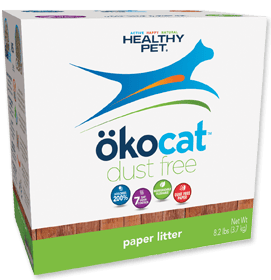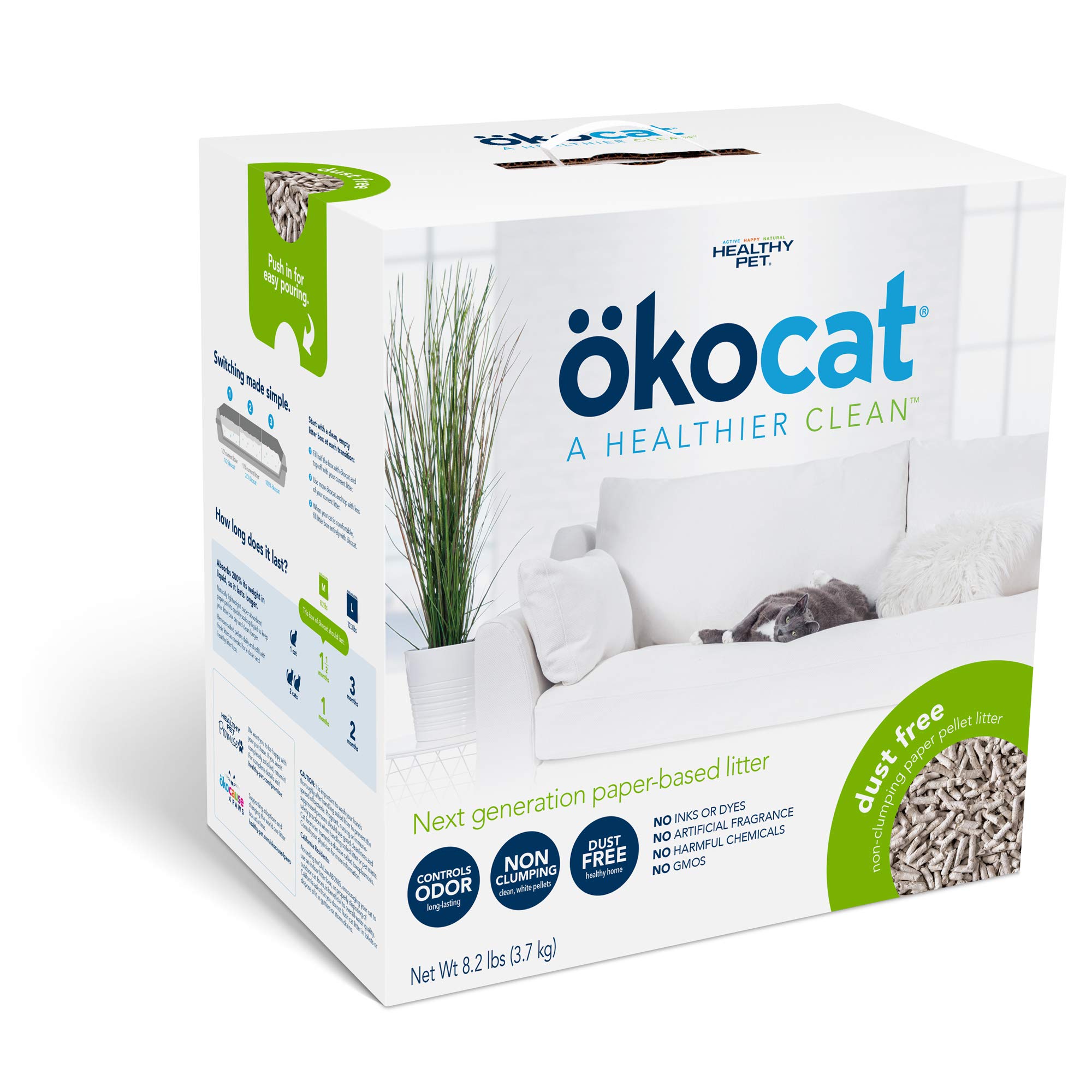Exploring environmentally conscious cat litters is not only beneficial for our planet but also for our feline friends. When faced with the question, “what can you use instead of cat litter?“, it’s clear there are numerous sustainable options.
Eco-friendly alternatives not only support our environment but ensure our pets are cared for in a healthy space.
To navigate the shift effectively:
- Opt for biodegradable materials that decompose naturally, lessening environmental impact.
- Seek out natural odor control options to maintain a fresh and clean home environment.
- Consider the absorbency and clumping factor of alternatives to ensure they meet your cat’s needs and maintain cleanliness.
Key Takeaways: Eco-Friendly Cat Litter Alternatives
In our journey to discover sustainable and eco-friendly cat litter alternatives, we’ve explored a variety of options that offer environmental benefits without compromising on performance. Here are the key points from our exploration:
- Diverse Materials: From pine and bamboo to recycled paper and textiles, there’s a wide range of sustainable materials available for cat litter, each with unique benefits like odor control, moisture absorption, and compostability.
- Eco-Friendly Benefits: Choosing alternatives such as diatomaceous earth, pea fiber, or corn husk litter helps reduce landfill waste, minimizes chemical use, and supports a sustainable lifestyle, making a positive impact on our planet.
- Health and Safety: Many eco-friendly litters are non-toxic and dust-free, making them safer for cats and people alike, especially for those with respiratory issues or sensitive skin.
- Why It Matters: Switching to eco-friendly cat litter not only contributes to a healthier environment by reducing landfill waste and avoiding harmful chemicals but also ensures the well-being of our furry friends and family members.
- Take Action: Encourage cat owners to experiment with different sustainable litter options to find the best fit for their pet’s needs and their environmental values. Share your experiences or recommendations to help others make informed decisions.
You may also be wondering – Is Grass Seed Litter Safe for Cats?
Top 20 Eco-Friendly Cat Litters
Let’s dive into ten sustainable alternatives that are both cat-friendly and earth-friendly, showcasing cat sand durability and biodegradable materials.
1) Recycled Paper Litter – An Answer to Lifespan Concerns
Recycled paper cat litter is made from—you guessed it—recycled paper products. This could be old newspapers, magazines, or other paper waste that’s processed into pellet or granule form. It’s a natural, biodegradable option that appeals to eco-conscious cat owners. But just because it’s environmentally friendly doesn’t mean it’s the best fit for every household. Let’s explore some popular brands and weigh the pros and cons.
ökocat Natural Paper Cat Litter
ökocat offers a lightweight option that’s free of chemicals, dyes, and fragrances. It’s highly absorbent and soft on your cat’s paws. However, it may not offer the best odor control for multi-cat households.


Fresh News cat litter
Fresh News: Another popular option, Fresh News litter is made from post-consumer paper products and is known for its odor control and low dust. It’s a great option for people with allergies, but the larger pellets may be off-putting for cats used to finer textures.
The Benefits and Drawbacks of Recycled Paper Cat Litter
| Benefits | Drawbacks |
| Eco-Friendly: Made from recycled materials, reduces paper waste, biodegradable | Odor Control: May not control odor as well as clay litters. |
| Gentle on Paws: Soft pellets ideal for kittens or sensitive paws. | Non-Clumping: Requires more frequent changes, lacks convenience. |
| Low Dust: Great for allergy sufferers, nearly dust-free. | Tracking: Lightweight pellets may stick to paws and track outside the box. |
| Lightweight: Some brands offer lightweight formulas, easier to clean up. |
2) Bamboo Cat Litter – Sustainability and Absorbency
Bamboo litter, as a fast-growing resource, provides an eco-friendly solution without compromising on absorbency.
- Renewable: Bamboo grows quickly, making it a sustainable choice.
- Absorbent: Effectively controls moisture.
- Low environmental impact: Requires less water and no pesticides to grow.
3) Wood Pellets – Natural and Compostable
Wood pellets, made from sawdust byproducts, are natural and compostable, addressing decomposition of biodegradable cat litter.
- Sustainable: Utilizes industrial byproducts.
- Compostable: Can be broken down into natural compounds.
- Odor control: Naturally minimizes smells.
4) Barley or Wheat Litter – Clumping Factor and Eco-friendliness
Grain-based litters, such as barley or wheat, are sustainable options that offer natural odor control.
- Clumping: Makes cleaning easier.
- Eco-friendly: Fully biodegradable.
- Natural odor control: Keeps the litter box fresh without chemicals.
5) Coconut Husk Litter – Innovative and Sustainable
Coconut husk litter utilizes a waste product of the coconut industry, making it an innovative and sustainable choice.
- Highly absorbent: Locks in moisture effectively.
- Lightweight: Easy to handle and change.
- Sustainable: Made from coconut industry byproducts.
6) Tofu Cat Litter – Safe and Biodegradable
Tofu cat litter is biodegradable, flushable, and made from food-grade materials, making it safe for cats.
- Biodegradable: Eco-friendly disposal.
- Flushable: Convenient and hygienic.
- Safe: Made from natural, non-toxic materials.
7) Peat Moss Litter – Absorbency and Sustainability
Peat moss is highly absorbent and compostable, though sourcing sustainability is key.
- Absorbent: Keeps litter box dry.
- Compostable: Can be used in gardens after use.
- Sustainable sourcing: Important for environmental conservation.
8) Corn Cob Litter – Light and Biodegradable
Corn cob litter is lightweight, biodegradable, and made from a renewable resource.
- Economical: Cost-effective and efficient.
- Biodegradable: Easy to dispose of responsibly.
- Lightweight: Makes cleaning and refilling simple.
9) Grass Seed Litter – A New Eco-friendly Option
Grass seed litter is a newer, eco-friendly option that is both soft for cats and compostable.
- Soft texture: Comfortable for cats.
- Eco-friendly: Made from renewable resources.
- Compostable: Turns into natural fertilizer.

10) Hemp Litter – Superior Odor Control and Sustainability
Hemp litter, made from hemp plant fibers, is sustainable, biodegradable, and offers superior odor control.
- Sustainable: Grows without much water or pesticides.
- Odor control: Naturally minimizes unpleasant smells.
- Biodegradable: Breaks down easily without harming the environment.
11) Pine Litter – Natural and Refreshing
Pine litter, with its natural wood scent and non-toxic properties, offers a refreshing change from traditional clay litters, actively neutralizing odors in your home.
- Eco-Friendly: Crafted from sustainably sourced pine.
- Odor Neutralizing: Naturally eliminates odors without chemicals.
- Non-Toxic: Safe for all pets, ensuring a healthy environment.
12) Newspaper Litter (DIY) – Recycle with a Purpose
Creating DIY newspaper cat litter not only promotes recycling but also provides a low-cost, highly absorbent alternative for environmentally conscious cat owners.
- Recycling at Its Best: Upcycles old newspapers, reducing waste.
- Cost-Effective: A budget-friendly option for cat litter.
- Highly Absorbent: Excellently manages moisture, keeping the box dry.
13) Silica Gel Crystals – High Absorbency and Odor Control
Silica gel crystals, known for their rapid moisture absorption and long-lasting odor control, offer a low-maintenance solution for busy pet parents.
- Moisture Lock: Captures liquid efficiently, reducing mess.
- Odor Control: Battles odors for a fresher litter box.
- Low Maintenance: Requires fewer changes, simplifying pet care.
14) Grass Litter – Gentle and Eco-Friendly
Biodegradable grass seed litter combines gentle texture with effective moisture management, making it an ideal choice for sensitive cats and eco-aware households.
- Soft on Paws: Ensures comfort for your cat’s daily use.
- Eco-Friendly: Breaks down naturally, lessening environmental impact.
- Effective Moisture Management: Quickly absorbs urine, keeping areas clean.
15) Walnut Shell Litter – Natural and Clumping
Walnut shell litter uses the natural clumping and odor-neutralizing qualities of walnut shells, providing a sustainable and dust-free cat litter solution.
- Sustainable: Utilizes waste walnut shells, reducing landfill.
- Natural Clumping: Facilitates easy cleanup.
- Odor-Neutralizing: Controls smells effectively without artificial fragrances.
16) Diatomaceous Earth Litter – Natural and Dust-Free
Diatomaceous earth litter, with its fossilized remains of algae, offers exceptional absorbency and natural flea control, presenting a safe, chemical-free option for indoor cats.
- Highly Absorbent: Maintains a dry litter box.
- Natural Flea Control: Helps prevent pest infestations.
- Chemical-Free: Protects pet health by avoiding toxins.
17) Pea Fiber Litter – Sustainable and Biodegradable
Pea fiber litter stands out for its sustainability and biodegradability, offering a low-impact and odor-controlling alternative that’s gentle on the planet and your pet.
- Sustainable Materials: Made from renewable pea fibers.
- Biodegradable: Leaves a minimal environmental footprint.
- Odor Control: Naturally manages odors, maintaining freshness.
18) Corn Husk Litter – Lightweight and Natural
Corn husk litter provides a lightweight, compostable option that excels in natural odor control, making it an excellent choice for eco-conscious cat owners seeking a renewable litter solution.
- Lightweight: Simplifies maintenance and disposal.
- Compostable: Supports eco-friendly waste management.
- Natural Odor Control: Keeps the litter area pleasant and fresh.
19) Recycled Textile Litter – Soft and Absorbent
Recycled textile litter, made from upcycled fabrics, offers a uniquely soft and super absorbent bedding for cats, reducing waste and promoting a sustainable lifestyle.
- Soft Texture: Prioritizes cat comfort.
- Super Absorbent: Effectively locks in moisture.
- Sustainable: Contributes to reducing fabric waste.
20) Wheatgrass Litter – Fresh and Compostable
Wheatgrass litter brings a fresh approach to cat care, with its compostable materials and natural odor-fighting capabilities, appealing to those looking for green and effective alternatives.
- Fresh Scent: Improves air quality around the litter box.
- Compostable: Enhances soil when composted.
FAQ Section
Q: What Alternatives Can I Use for Cat Litter?
A: Common alternatives to cat litter include sand, sawdust, shredded newspaper, wood pellets, and chicken feed. Each alternative has its own pros and cons, like absorbency and odor control.
Q: Is There a Suitable Replacement for Cat Litter?
A: Yes, there are several suitable replacements for cat litter. Sand, wood shavings, and shredded newspaper are some easily accessible options. They offer different benefits in terms of absorbency and odor control.
Q: What Can Be Used if Cat Litter Is Unavailable?
A: If cat litter is unavailable, you can use alternatives like sand, sawdust, wood pellets, shredded newspaper, or even chicken feed. These materials can temporarily substitute for traditional cat litter.
Q: What Can I Use If I Don’t Have a Litter Box?
A: In the absence of a litter box, you can create a makeshift one using a shallow container filled with cat litter alternatives like sand, shredded newspaper, or wood shavings. These materials can serve as temporary solutions.
Further Reading
Are There Eco-Friendly Cat Litter Disposal Options?
Cats and the Unavoidable Litter Box – Pet Planet
Wrapping It Up: A Greener Pawprint
Choosing an environmentally conscious cat litter alternative is a meaningful step towards a more sustainable lifestyle. Revisiting the question, “What can you use instead of cat litter?” reminds us of the importance of selecting products that support our planet’s health.
- Eco-Friendly Choices: Opting for alternatives like recycled paper or bamboo helps reduce waste.
- Sustainability: Using biodegradable materials contributes to a healthier environment.
So, why stick with the old when you can go green and clean? Choosing earth-friendly cat litter not only helps our planet but also sparks joy in our daily chores. Isn’t it cool to know that every scoop and shake can make a big difference? Let’s leave a lighter footprint, one litter at a time, and keep asking the right questions for a brighter, greener future.


